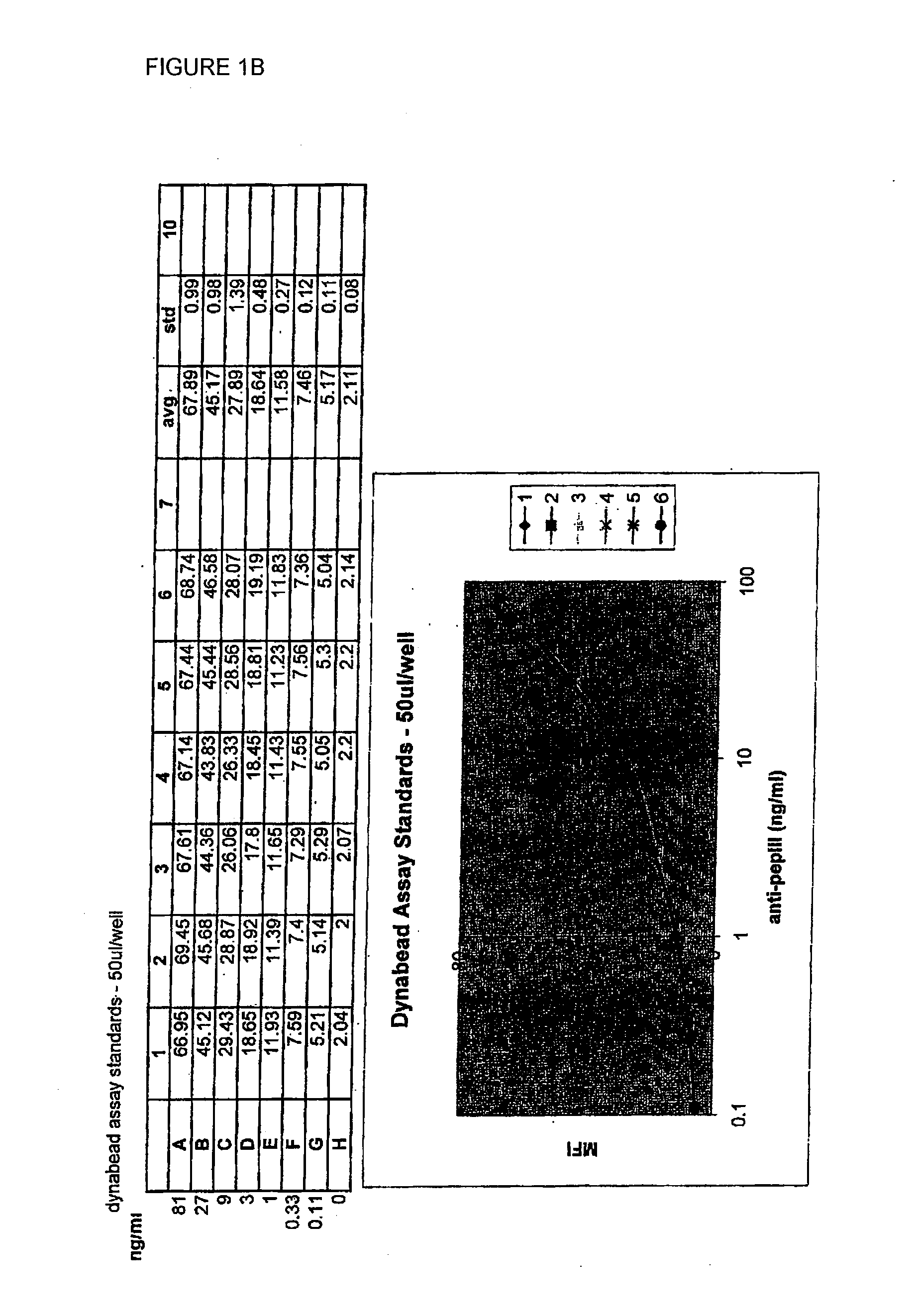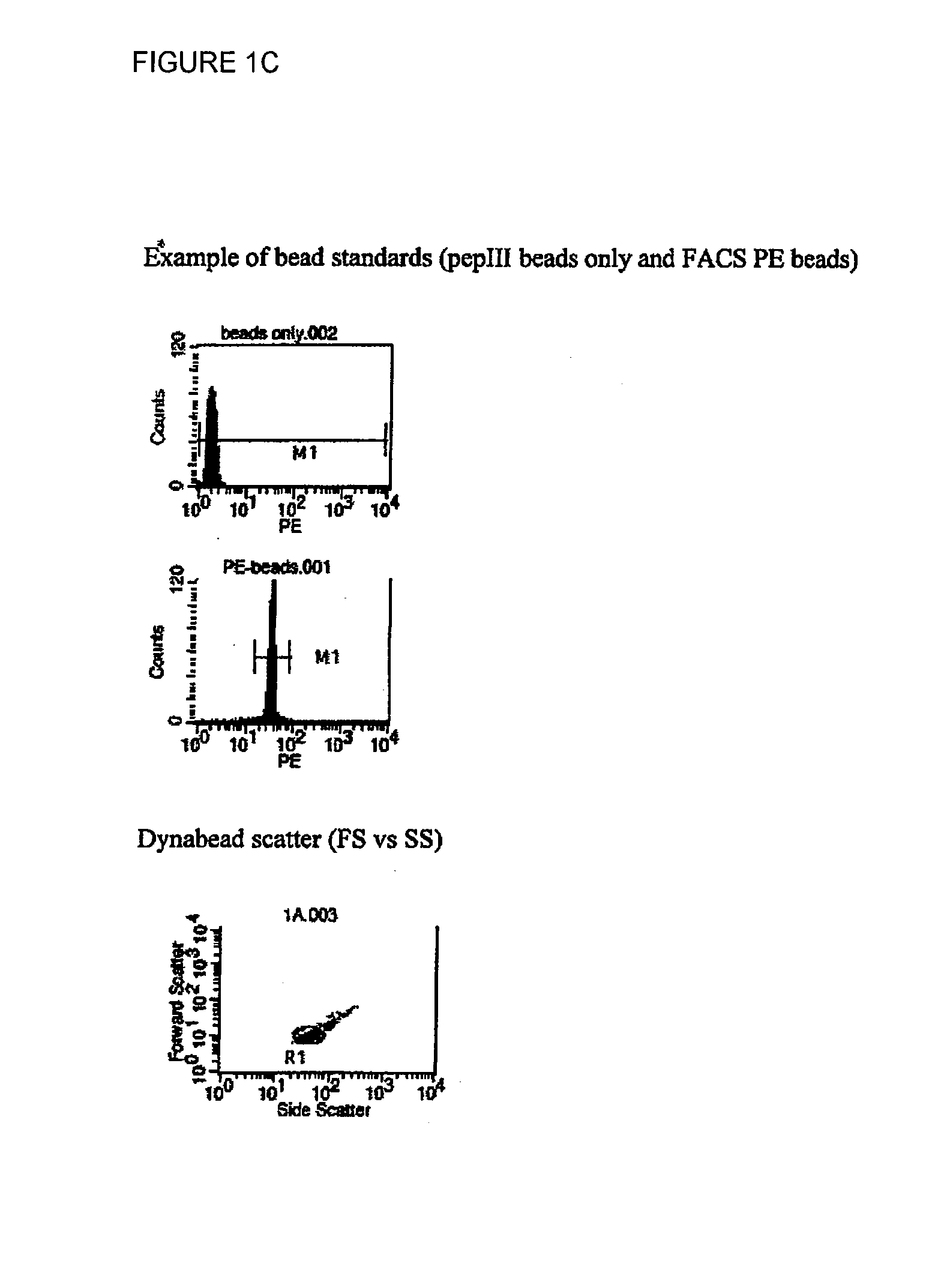ASSAY FOR ANTI-EGFRvIII ANTIBODIES
a technology of antibodies and anti-egfrviii, applied in the field of clinical research and patient monitoring, can solve the problems of lack of effectiveness and undesirable side effects, difficult to identify tumor-specific molecules, and cancer remains a health issu
- Summary
- Abstract
- Description
- Claims
- Application Information
AI Technical Summary
Benefits of technology
Problems solved by technology
Method used
Image
Examples
example 1
Conjugation of PepIII peptide to Magnetic Beads
[0041]The PepIII portion of EGFRvIII was covalently linked to magnetic Dynabeads®(Dynal, Invitrogen M-280 Tosylactivated) according to the manufacturer's instructions. Briefly, the beads and PepIII were incubated overnight in borate buffer (pH 9.5) at 37° C. using an end-over-end mixer. The following day the beads were washed with Phosphate Buffered Saline+Bovine Serum Albumin (PBS+BSA) followed by incubation in 0.1M Tris (pH9) to block any remaining active sites on the beads. The beads were adjusted to 2×108 beads / ml in PBS+0.1% BSA+0.25% Sodium Azide and stored at 2-8° C.
example 2
Detection of Anti-EGFRvIII Antibodies Using Fluorescently Labeled Anti-Human Secondary Antibody
[0042]The wells of a polystyrene flat bottom 96 well plate were prepared by adding 200 μl of a PBS+1% BSA solution to each well and incubating the plate for 30 minutes at 37° C. After this incubation, the solution was decanted and excess liquid was blotted.
[0043]Three types of sample were added to the plate: serum from a patient known to contain anti-pepIII antibody, serum from a patient known to have no antibody, and a third sample set containing defined amounts of a known anti-pepIII antibody. The third sample set was used to create a standard curve, which allows correlation of the amount of fluorescence to a known amount of antibody.
[0044]Samples from patient serum were diluted 1:10 with PBS+1% BSA before use. 50 μl of each sample was added into the wells. To determine the specificity of anti-pepIII antibody binding, 450 ng (20 μl of a 25 μg / ml solution) of free pepIII peptide was added...
example 3
Elution of Anti-EGFRvIII Antibody from Beads
[0049]Anti-pepIII antibodies were bound from samples, essentially as described above, in 50 μl samples in a 96-well plate. Each well also contained 20 μl of pepIII-conjugated-dynabeads The beads with bound antibody were washed for 30 minutes on a mixer in the PBS+0.1% Tween 20. 100 μl of elution buffer was added and the beads were incubated for 30 seconds. After 30 seconds, 13 μl of neutralization buffer was added. The beads were re-isolated and rinsed with Wash Buffer. Both the beads and the eluted supernatant were retained.
[0050]The eluted supernatant from each of six samples were analyzed to measure the presence of anti-pepIII antibody by a second round of binding to pepIII-conjugated beads in the presence and absence of free peptide.
[0051]FIG. 2 shows the results obtained by following this method. PG serum sample was taken from a normal donor who did not have antibodies to EGFRvIII for use as a negative control. ACT4 is from a patient ...
PUM
 Login to View More
Login to View More Abstract
Description
Claims
Application Information
 Login to View More
Login to View More - R&D
- Intellectual Property
- Life Sciences
- Materials
- Tech Scout
- Unparalleled Data Quality
- Higher Quality Content
- 60% Fewer Hallucinations
Browse by: Latest US Patents, China's latest patents, Technical Efficacy Thesaurus, Application Domain, Technology Topic, Popular Technical Reports.
© 2025 PatSnap. All rights reserved.Legal|Privacy policy|Modern Slavery Act Transparency Statement|Sitemap|About US| Contact US: help@patsnap.com



